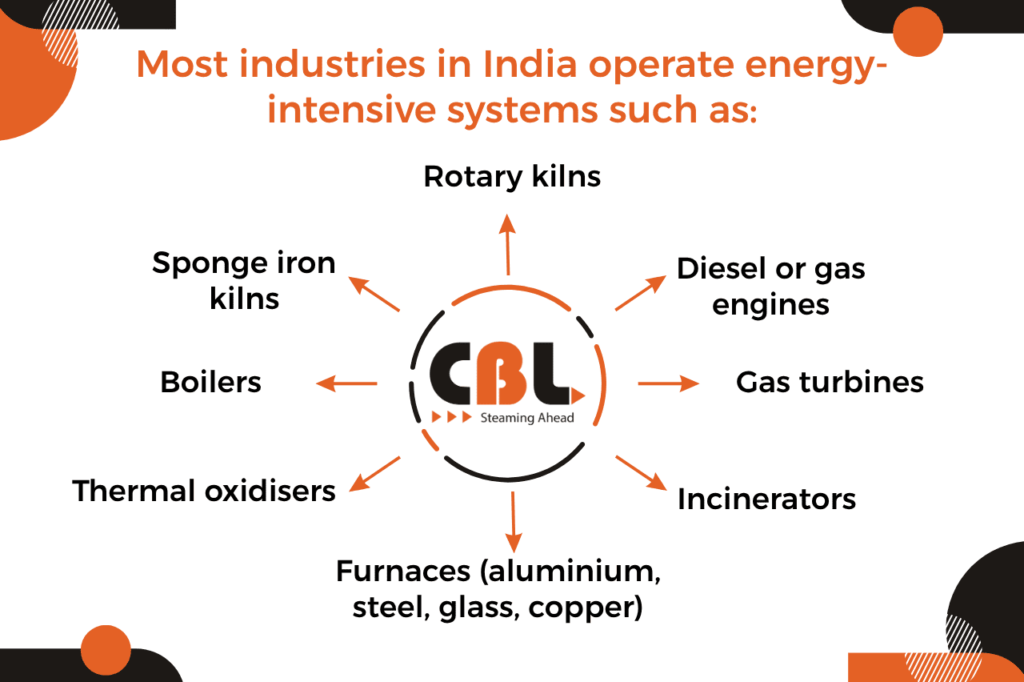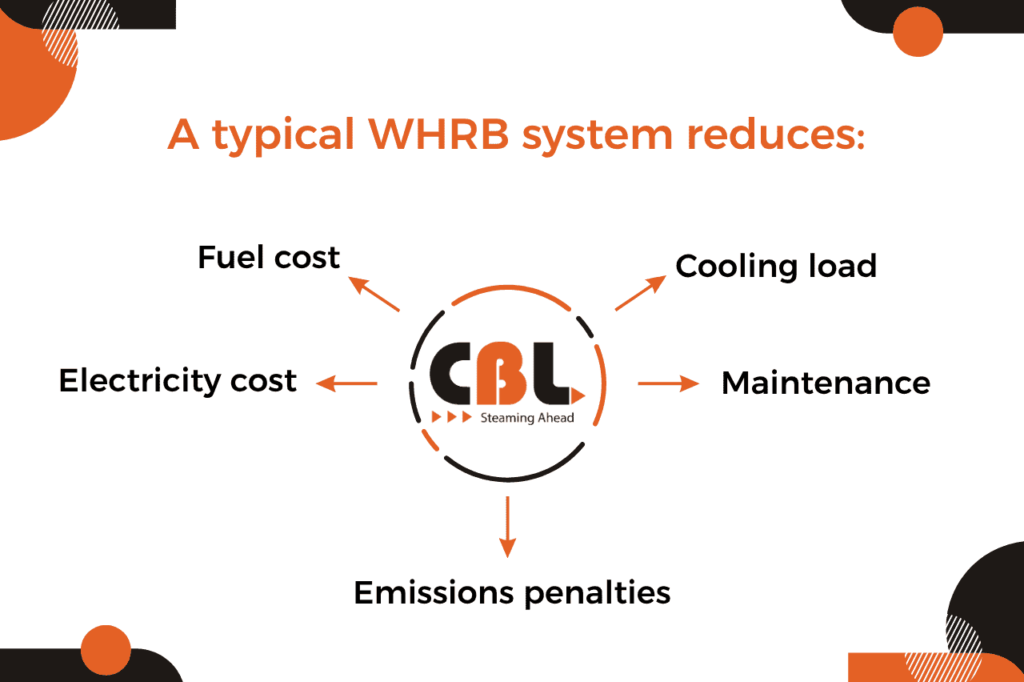Industries in India are growing at a rapid pace—but so are their fuel costs, operational expenses, and pressure to meet sustainability targets. Whether it’s a cement plant, steel unit, refinery, fertilizer industry, textile mill, or chemical plant, one challenge remains the same:
Energy is the biggest operational cost in Indian industries.
Fuel prices have increased sharply in the last decade. Electricity tariffs continue to climb. Environmental regulations are becoming stricter. Competitors are getting leaner and adopting efficient technologies faster.
In such a scenario, the biggest question for India’s industrial sector is:
**How can we cut energy costs without affecting production?
The answer: Waste Heat Recovery Boilers (WHRBs).**
Cheema Boilers, Mohali—one of India’s trusted industrial boiler manufacturers—has been designing high-efficiency WHR boilers and industrial waste heat recovery boiler systems that help industries save crores every year.
This blog explains, in simple + technical detail, how Waste Heat Recovery Boilers reduce energy costs, why they are becoming mandatory in 2025, and how industries across India are benefiting from them.
What Is a Waste Heat Recovery Boiler (WHRB)?
A Waste Heat Recovery Boiler is a specially engineered boiler that captures the heat normally lost into the atmosphere from:
✔ exhaust gases
✔ flue gases
✔ kilns
✔ furnaces
✔ chimneys
✔ chemical reactions
✔ turbine exhaust
✔ drying, roasting, calcination or melting processes
and converts it into useful steam or power.
Instead of generating heat using expensive fuels (coal, gas, oil, FO, LDO, HSD), a WHRB recycles the heat that your plant is already producing but wasting.
This makes WHRB one of the most cost-effective and environment-friendly steam generation technologies available today.
Why Indian Industries Waste So Much Heat?

Most industries in India operate energy-intensive systems such as:
Rotary kilns
Sponge iron kilns
Boilers
Thermal oxidisers
Diesel or gas engines
Gas turbines
Furnaces (aluminium, steel, glass, copper)
Incinerators
Calcination units
Dryers
All these systems release extremely hot flue gases—often between 250°C to 950°C.
This heat is normally allowed to escape the stack unused.
In many plants, 30–40% of total heat produced is lost into the environment.
This is equivalent to burning money.
A high-efficiency WHRB by Cheema Boilers Mohali captures this heat and converts it into:
Steam
Hot water
Power (via steam turbines)
Pre-heated air
Pre-heated feed water
This directly reduces fuel consumption and operational cost.
How WHRB Boilers Reduce Industrial Energy Costs (Step-by-Step)
Below is a detailed breakdown of how WHR boilers drastically reduce energy expenses in Indian industrial plants:
A. They Reduce (or Eliminate) Fuel Consumption
A conventional boiler burns fuel to produce steam.
A WHRB produces the same amount of steam—but without burning fuel.
This means industries cut:
✔ Coal consumption
✔ Diesel / FO / LDO usage
✔ Gas consumption
✔ Biomass cost
✔ Electricity usage (for captive steam generation)
Industries typically save:
15–45% of their monthly fuel bill depending on process.
B. They Reduce Electrical Energy Consumption
Many plants buy costly electricity or run captive power plants.
A WHRB:
Generates free steam →
Drives steam turbine →
Produces free electricity
Industries using WHRB for power generation save between:
₹30 lakh/month to ₹2 crore/month
depending on size.
C. They Reduce Cooling Costs
Before WHRB systems existed, plants cooled hot gases using water, ID fans, or cooling towers.
This wasted water + power.
A WHRB absorbs that heat—reducing cooling load and saving:
✔ Water
✔ Pumping electricity
✔ Cooling tower maintenance cost
✔ Fan power
D. They Improve Production Efficiency
Recovering heat stabilises temperature inside the plant, improving:
Kiln efficiency
Turbine efficiency
Heater performance
Furnace quality
Chemical reaction rates
This leads to:
✔ Fewer breakdowns
✔ Less scale formation
✔ Longer refractory life
✔ Better product quality
✔ Higher production output
E. They Reduce Carbon Emissions (ESG Compliance)
Every tonne of fuel saved reduces CO₂ emissions.
A typical WHRB system reduces:
5,000 – 50,000 tonnes of CO₂ per year.
This helps industries meet:
Government norms
ESG reporting
Sustainability goals
Export compliance
F. They Lower Overall Operating Cost (OPEX)
WHRBs reduce:
✔ Fuel cost
✔ Electricity cost
✔ Cooling cost
✔ Maintenance cost
✔ Water cost
✔ Pollution control cost
This is why WHRBs offer the fastest ROI among industrial systems—usually in 1–3 years.
Which Industries Benefit the Most From WHRB in India?

WHR boilers are used in almost every major sector that has high-temperature exhaust.
🔥 Cement Plants
One of the biggest users of WHRBs in India.
Rotary kiln exhaust provides massive heat energy.
Savings: ₹5–10 crore/year
🔥 Steel & Sponge Iron Plants
Rotary kilns (DRI), EAF, reheating furnaces produce huge thermal energy.
Savings: ₹3–12 crore/year
🔥 Power Plants
Gas turbine exhaust used for HRSG/WHRB.
Savings: ₹10–50 crore/year
🔥 Refineries & Petrochemicals
Process heaters, crackers, and incinerators release enormous heat.
Savings: ₹8–20 crore/year
🔥 Glass, Aluminium, Copper, Zinc, Non-Ferrous Industries
Furnace exhaust energy is extremely high.
Savings: ₹2–8 crore/year
🔥 Chemical, Fertilizer & Pharmaceutical Plants
Cooling and drying processes release reusable heat.
Savings: ₹50 lakh – ₹3 crore/year
🔥 Textile & Paper Mills
Huge use of thermal energy for drying.
Savings: ₹10–25 lakh/month
Types of Waste Heat Recovery Boilers Used in India
Cheema Boilers Mohali manufactures all major types of WHRBs, depending on:
Temperature of exhaust
Gas composition
Industry type
Utility requirements (steam, hot water or power)
1. Water Tube WHRB
High pressure steam
For cement, steel, power
Very durable & efficient
2. Fire Tube WHRB
Lower pressure
Smaller industries
Affordable cost
3. Horizontal WHRB
Low maintenance
Suitable for chemical, fertilizer
4. Vertical WHRB
Space-saving
Suitable for power & cement
5. HRSG (Heat Recovery Steam Generator)
For gas turbines
Produces steam + power
6. Hybrid WHRB
Uses waste heat
PLUS optional fuel firing
Useful when exhaust heat fluctuates
Each type is designed by Cheema Boilers based on custom industrial requirements.
Waste Heat Recovery Boiler Price in India (2025 Updated)
The waste heat recovery boiler price in India depends on:
Boiler capacity
Industry type
Exhaust temperature
Pressure levels (TPH / kg/cm²)
Material metallurgy
Dust load in flue gases
Automation level
Heat exchanger design
Additional systems (bag filters, ESP, chimney, ID fans)
Indicative WHRB Pricing:
Small WHRB (1–3 TPH): ₹35 lakh – ₹90 lakh
Medium WHRB (5–15 TPH): ₹1.2 crore – ₹6 crore
Large WHRB (20–60 TPH): ₹8 crore – ₹30 crore
Complete WHR Power Plant System: ₹15 crore – ₹80 crore
Cheema Boilers provides custom quotations after a technical site assessment.
Why WHRB Adoption Is Increasing Fast in India
Indian industries are shifting rapidly toward energy-efficient solutions.
The reasons:
1. Rising Fuel Prices
Industries cannot afford high coal, oil, and gas expenses.
2. Mandatory Sustainability Targets
Pollution control norms require CO₂ reduction.
3. Competitive Pressure
Industries with WHRB spend 30–40% less on energy.
4. Government Push
Subsidies and incentives for energy-efficient projects.
5. Quick ROI
WHRB systems pay back in 1–3 years.
6. Technology Advancement
Cheema Boilers Mohali has introduced highly efficient WHRB designs for cement, steel, and chemical plants.
Why Choose Cheema Boilers Mohali for WHRB Systems?
Cheema Boilers Limited (CBL), located in Mohali, Punjab, is one of India’s leading waste heat recovery boiler manufacturers with decades of engineering expertise.
✔ 1. Industry-Leading WHRB Designs
CBL WHRBs are engineered for:
High dust load
High temperature
High pressure
Low maintenance
Maximum heat absorption
360° reliability
✔ 2. Proven Performance in Over 100+ Industrial Installations
WHRB installations across:
Punjab
Rajasthan
Gujarat
Uttar Pradesh
Chhattisgarh
Odisha
Maharashtra
Tamil Nadu
✔ 3. Expertise in Cement, Steel, Chemical & Power Sectors
No matter how complex your flue gas conditions, Cheema Boilers has a solution.
✔ 4. Custom Engineering for Indian Industry Conditions
Indian plants have:
Unstable process conditions
High dust in exhaust
Variable temperature
Harsh climate
CBL WHRBs are designed specifically for this environment.
✔ 5. End-to-End Project Execution
From design → manufacturing → installation → commissioning → service.
✔ 6. Superior ROI & Efficiency
CBL boilers offer higher heat recovery than most suppliers, reducing payback periods.
ROI (Return on Investment) of a WHRB System

A typical WHRB system reduces:
Fuel cost
Electricity cost
Cooling load
Maintenance
Emissions penalties
ROI Calculation Example (Cement Plant)
| Parameter | Value |
|---|---|
| Heat available | Very high |
| Steam produced | 20–30 TPH |
| Power generated | 4–12 MW |
| Monthly savings | ₹1.5 – ₹6 crore |
| ROI | 12–30 months |
ROI Example (Steel Plant)
| Parameter | Value |
|---|---|
| Kiln exhaust | 600–950°C |
| Steam produced | 10–40 TPH |
| Annual savings | ₹3–12 crore |
| ROI | 18–36 months |
ROI Example (Chemical Plant)
| Savings per year | ₹50 lakh – ₹3 crore |
| Payback Period | 1–2.5 years |
Even conservative cases show outstanding financial returns.
Final Conclusion
India’s industries are under constant pressure to:
Reduce costs
Improve efficiency
Decrease emissions
Increase productivity
Stay globally competitive
Waste Heat Recovery Boilers are no longer optional—they are a necessity for every modern industrial plant.
By recovering heat that is being wasted every day, WHRBs offer:
Massive cost reduction
Higher profitability
Cleaner operations
Long-term sustainability
As one of the leading waste heat recovery boiler manufacturers in India,
Cheema Boilers Mohali delivers world-class WHRB systems engineered for maximum performance and reliability.
If your plant generates high-temperature exhaust, you are losing lakhs—maybe crores—every month.
And a WHRB can recover it.

